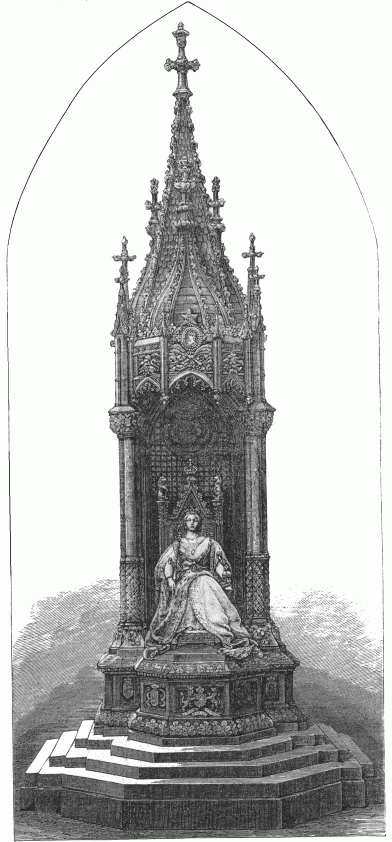► Royal Navy ► Varia
| STATUE OF THE QUEEN AT BOMBAY. Illustrated London News, 8 June 1872 | |
| The marble statue of her Majesty Queen Victoria, enthroned under a marble canopy, presented by his Highness the Guicowar of Baroda to the Victoria Gardens at Bombay, was lately unveiled by the Governor. It represents her Majesty as seated in the House of Lords, and attired in her robes of state. On her head is the Royal diadem, and the sceptre is held in her right hand, while the left holds the globe. Over her breast is placed the badge of the Order of the Garter, accompanied by the Collar and Star of India. The likeness is admirable, and there is great dignity and repose in the figure, which is about 8 ft. 6 in. high. It is executed in the finest Carrara marble. The canopy is executed principally in the best Sicilian marble, but the columns and back are of light Sienna marble. The Royal arms are sculptured on the front of the pedestal, and the Star of India on the centre of the canopy. On the enriched part immediately above the statue are the rose of England and lotus of India, accompanied by the mottoes. "God and My Right" and "The Light of Heaven our Guide." Other accessories have been introduced into the design, such as the oak and ivy leaves, respectively the symbols of strength and friendship, adorning the plinths and capitals of the columns; with the oak, ivy, and lotus leaves enriching the mouldings that surround the whole. On the four panels at the sides and back of the canopy are inscriptions in four different languages - namely, in English and in three Indian languages. The canopy is about 45 ft. high; the width of the lower part of the base is, from side to side, 18 ft., and from front to back, 22 ft. About 350 tons of marble were used in the construction of this grand monument. The sculptor is Mr. Matthew Noble, of London. | |
The log of HMS Glasgow, in which William Loney was serving, reveals that that the Flying Squadron, then at Bombay, fired a Royal Salute to mark the unveiling of this statue on 29 April 1872.
Matthew Noble , the sculptor, was born at Hackness, near Scarborough, on 23rd March 1817. He was a son of Robert Noble, a stone mason, and served his apprenticeship with his father. He early developed talent as a sculptor, and was enabled by Sir John Johnstone to go to London and study under the portrait sculptor John Francis (as did the sculptor of the statue of Lord Mayo in Calcutta). He afterwards married Francis' niece. He exhibited regularly at the Royal Academy from 1845 until his death in 1876. He became recognised after winning the competition to build the Wellington Monument in Manchester in 1856.
, the sculptor, was born at Hackness, near Scarborough, on 23rd March 1817. He was a son of Robert Noble, a stone mason, and served his apprenticeship with his father. He early developed talent as a sculptor, and was enabled by Sir John Johnstone to go to London and study under the portrait sculptor John Francis (as did the sculptor of the statue of Lord Mayo in Calcutta). He afterwards married Francis' niece. He exhibited regularly at the Royal Academy from 1845 until his death in 1876. He became recognised after winning the competition to build the Wellington Monument in Manchester in 1856.
Top↑
 |
